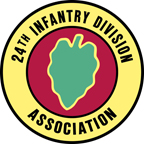Mindoro Beach Landing Question Solved!
Rich and Julius Delpizo
January 2, 2009
I'm sending this in the hopes that you could perhaps help my father, Julius Delpizzo, Sergeant, K Company, 19th Regiment, 24th Division, WWII.
In late December 1944 in the Philippines he was part of the Mindoro beach landing starting on December 15. After advancing a few miles inland, they were on a bluff overlooking the bay.
The large Allied naval battle group in the bay was under attack by Japanese planes. One of the ships was a large cargo ship. My father recalls seeing a plane fly toward the cargo ship. Soon after that, there was a flash from the area of ships and the cloud that erupted went into the sky and leveled off — a mushroom type cloud.
After several seconds, the ground under my father began to shake and they were all thrown to the ground. When they got up the ship had vanished!
My father has been wondering all these years if anyone has information on this incident, particularly the ship's name, and what happened to the crew.
Rich Delpizzo
I suggested Rich use the internet to search Google for "Mindoro beach cargo ship liberty class." ED.
Jnauary 4, 2009
Thank you for such a quick response. I tried your suggestion to search Google — and we found our answer! Here are some extracts.
WAR SHIPPING ADMINISTRATION (Washington); ADVANCE RELEASE – “Two Liberty ships were blown up by enemy attack off Mindoro with the loss of all on board. Sixty-eight merchant seamen were killed on the SS John Burke while 71 died on the Lewis L. Dyche. Both disasters occurred during the Mindoro operation.”
I then searched for “SS John Burke,” and found the following from the log of the 8-12 watch onboard the USS BUSH (DD 529) for 28 December 1944:
· “1020 - Enemy planes attacking various units in rear portion of convoy. Two enemy planes crash dived on S.S. WILLIAM SHARON and S.S. JOHN BURKE (liberty ships).
· 1020-Tremendous explosion in center of convoy followed by minor explosions. S.S. JOHN BURKE was blown clear of water. Huge column of smoke obscured center of convoy.
· 1021-Enemy planes withdrew. Convoy ceased firing.
· 1104-Received visual message from LST 751 reporting that S.S. JOHN BURKE had blown up at 1020 when crash dived by enemy plane. (E. E. Sechrist, Lt.(jg)”
A further search found, quite incredibly, actual time-lapse photos of the event (see http://www.ussbush.com/slotow.htm).

The ammunition ship SS JOHN BURKE explodes after being hit by a
Japanese suicide plane December 28, 1944. All 68 hands aboard the
BURKE were lost. (For scale, see ships in lower right).
The images on this site were filmed on the morning of December 28, 1944 as the USS BUSH helped to escort a number of transports and supply ships bound for Mindoro Island in The Philippines. The supply ships were filled with ammunition, fuel and other materials.
The photos clearly show the mushroom cloud that my father recalls, as the ammunition ship SS JOHN BURKE explodes after being hit by a Japanese suicide plane. All 68 hands aboard the BURKE were lost. All images were shot on 16MM newsreel film from the decks of the USS BUSH, by the ship's Medical Officer, LT George Johnson.
My father’s memory of the resulting shock wave was accurate as it was noted that inside the Combat Information Center (CIC) on USS BUSH, former Executive Officer Tony Lilly recalled, "The shock was so fierce that I (in CIC) thought we had been hit."
Thank you for your help; after 64 years (almost to the day), my father finally got his answer.
What are the chances of a medical officer filming a newsreel using 16 mm film when the explosion happened? The internet is an amazing thing!
It will be interesting to see who else recalls this incident when this letter gets printed in the Taro Leaf; my Dad loves reading it.
Very Respectfully,
Rich Delpizzo, Julius Delpizzo, 5410 Charlottesville Road, Springfield, VA 22151,
The Taro Leaf, Vol 63(2) Spring 2009, pg. 12, 13, and 15.

